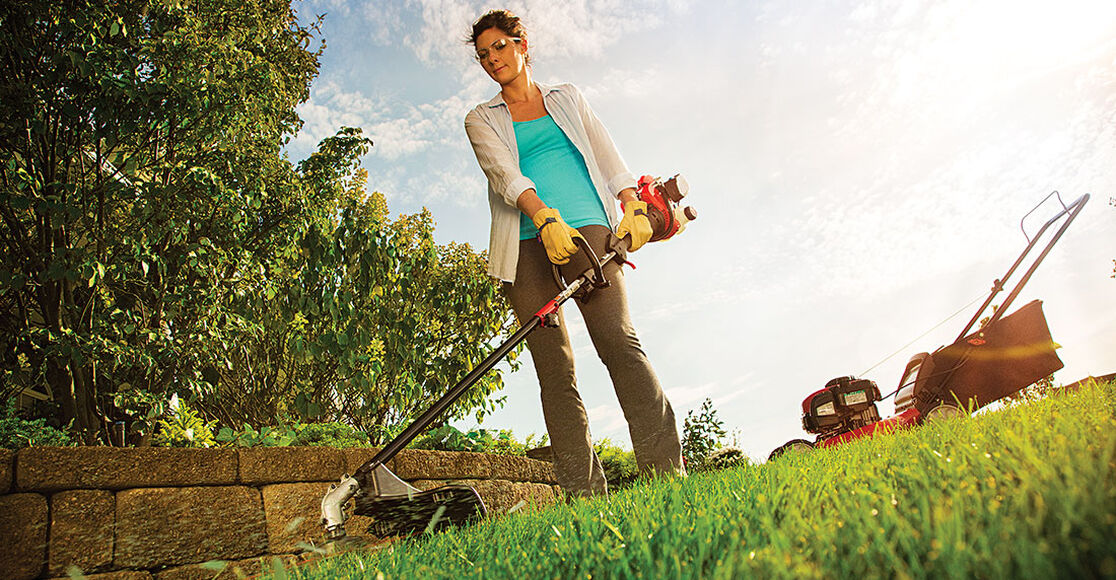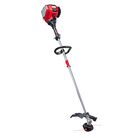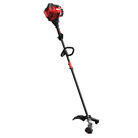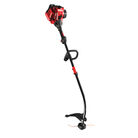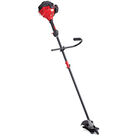A string trimmer can tackle a variety of different yard projects, making it one of the most versatile tools in the shed. Whether it’s tidying up walkways or removing grass from places your mower can't reach, string trimmers are a go-to tool for summer yard maintenance.
String trimmers are key for keeping your lawn neat, polished and looking just the way you want all summer long. For yard tasks like tidying up your walkways, under a deck or along a fence, your string trimmer will be your go-to tool.
Keep in mind there are different types of string trimmer models – 2-cycle and 4-cycle – so make sure you understand which type of string trimmer will fit your needs best and learn how it works before getting out in the yard.
It’s also important to take the design of your trimmer into account, as straight shaft and curved shaft trimmers have varying capabilities and are used for different purposes in the yard.
Straight shaft string trimmers are more comfortable for taller individuals to use, and ideal for trimming around fencing and other hard-to-reach places in the yard. Lighter in weight, curved shaft trimmers are ideal for shorter people and for projects that take more time to complete, like trimming sidewalks and areas within your landscape.
To get started, here are some operation and maintenance tips, tricks and techniques to consider so you can stay safe and be more efficient with your string trimmer:
Edging
Edgers are used to deliver a clean, crisp perimeter along driveways and walkways. However, if you have a small- to medium-sized yard, you can use your string trimmer as an edger for a more budget-friendly, effective option. Convert your trimmer into an edger by carefully turning your string trimmer so the strings rotate vertically during use.
Or, you can use the LE720 TrimmerPlus® Add-On Lawn Edger attachment to give your paths and flower beds a clean, crisp look. (Any attachment-capable Troy-Bilt® string trimmer can use TrimmerPlus attachments to convert into a variety of tools – like an edger, cultivator or hedge trimmer, among other tools).
Tapering
Trimmers like the TB25C Curved Shaft String Trimmer are built for hard-to-reach jobs like grass growth along trees, decks or fences, and in tight spaces and corners. When tending to these areas in your yard, hold your trimmer at a slight angle to get the trimmer head even with the mowed grass. Keep in mind trimmer lines can damage any trees growing nearby, so be careful not to hit them with your trimmer.
Trimming
The most obvious use for your string trimmer can also cause the most damage to your machine if used improperly. When cutting tall grass, begin trimming from the top down to prevent the string from getting tangled in the grass blades. When tackling bigger trimming jobs, start trimming in small sections rather than the whole yard all at once. This will prevent your tool from stalling or string from tangling.
Safety Tips
Remember to always wear long pants and closed-toed shoes when trimming, as well as safety goggles to protect your eyes from flying debris. Always follow safety precautions when operating a string trimmer; you can find a list of safety protocols in your owner’s manual. Other safety tips include:
- Make sure your yard is free of debris, toys and any other foreign yard objects before you start your trimmer. When a powered-on trimmer encounters an object, it will be unexpectedly and aggressively thrown. You’ll also want to make sure pets and bystanders are at least 50 feet away.
- Before starting your machine, make sure it is in proper condition (tool is clean, no loose screws or bolts, etc.). Don’t forget to check the fuel level and refill if low.
- When using a trimmer, make sure your weight is evenly distributed on both feet, on solid ground, with both hands firmly holding the machine’s handles.
- Following each trimming job, use a dry, clean brush to clear your trimmer of any remaining grass clippings and dirt.
- Always allow plenty of time for your string trimmer to cool down before storing it in a dry place. If you are storing it for a long period of time, be sure to empty the machine of all fuel.
Other Helpful Tips
Check to see in what direction your string trimmer is rotating. For example, if the strings in your trimmer rotate counterclockwise, that means that it cuts to the right and any chopped material and debris will come out of the left side of the trimmer. To prevent this material from building up in your cutting path, keep your body toward the cutting side.
You’ll also want to learn how to:
- Use the type of line feed system on your trimmer. Bump feeds offer simple, hands-free operation, requiring just a tap of the trimmer to release additional line at full throttle. A fixed line system is easy to refill with line, with no winding required – just simply install pre-cut line as needed.
- Cut thick, tall grass and weeds by tackling in small sections. Trying to trim too much at once can cause the trimmer to stall or the line may start to tangle; it can even strain the engine. For taller grass, you should trim from the top down in small sections.
- Transform your trimmer to complete other yard projects like blowing leaves, edging the lawn and cultivating the garden with TrimmerPlus® attachments. By using attachment-capable trimmers, you can easily complete multiple tasks with one tool.
- Run your machine on low power when trimming decorative plants and trees. Full-powered trimmers are more difficult to control and can damage delicate plants, as well as items like fences and sprinkler systems.
